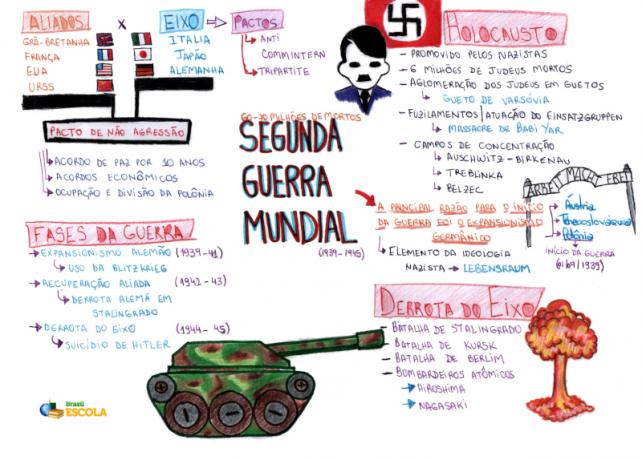THE Second World War was the biggest conflict in the history of mankind and had the participation Brazilian from 1944, with the dispatch of approximately 25,000 soldiers, who fought on the front of the battle in northern Italy. The performance of the Brazil in World War II also contributed to anticipate the end of Getúlio Vargas dictatorship.
Brazilian diplomatic relations
During the pre-war period, that is, in the 1930s, Brazil's foreign policy was to seek to ensure the best possible benefits from the two economic powers at that time: U.S and Germany. Thus, at that time, Brazil made a series of economic agreements with these two nations.
The United States had increased its influence on the international economy from the gradual recovery of its economy, and Germany, since the rise of the Nazis to power, he had initiated a policy to increase his influence, both ideological and economic, in Latin America.
The approximation actions carried out by Germany had a certain effect on its relationship with Brazil, as there was clearly a wing of the Brazilian army sympathetic to the Nazi cause and, in addition, a series of economic agreements was made between the two countries. As a result, as stated by historian Boris Fausto, Germany has become the largest buyer of Brazilian cotton and the second largest buyer of the coffee produced here
1.The agreements with Germany also yielded the supply of armaments for the Brazilian army. However, despite the partnership, Getúlio Vargas was inclined to turn to the United States, to the detriment of Germany. This was evidenced when he began to persecute the representatives of fascism in Brazil, known as integralists.
The beginning of World War II was essential for the definition of Brazil's foreign economic policy, as the maritime blockade imposed by the British made it impossible for Germans to maintain trade relations with Brazil, and this strengthened the position of the United States here, as new commercial possibilities arose with this scenery.
Mind Map - World War II

*To download the mind map, Click here!
The United States watched the increase in German influence in Brazil cautiously and, timidly, took measures aimed at increasing the presence of American culture and economy in Brazil and America Latin. This policy of bringing the United States closer to Latin America was known as good neighbor policy.
Economically, the United States negotiated a series of economic agreements to secure Brazil's support. This set of agreements guaranteed the transfer of rubber to the United States and the permission for the use of military bases in the Brazilian Northeast. In exchange, the Americans agreed to finance the construction of a steel plant in Volta Redonda and to supply Brazil with military equipment.
In the cultural field, American politics happened in a very intense way, with the president Franklin Delano Roosevelt naming Nelson Rockefeller to command actions that would increase the cultural influence of the United States in Latin America and, in particular, in Brazil. Rockefeller's team, along with Walt Disney, was responsible, for example, for the creation of Joe Carioca, Brazilian Disney character.
Do not stop now... There's more after the advertising ;)
With the growth of this cultural influence and with the consolidated economic agreements, the entry of the United States into the The war was essential for Brazil to take a diplomatic stance against the Axis (formed by Germany, Italy and Japan). Thus, in January 1942, Brazil broke diplomatic relations with the Axis.
Brazil goes to war
The German reaction to the breakup of diplomatic relations carried out by Getúlio Vargas took place in August 1942, when German submarines torpedoed and sank five Brazilian merchant ships. The attacks outraged public opinion, and Getúlio Vargas declared war on Germany that same month.
The declaration of war against the Axis made Brazil mobilize soldiers to be sent to the battlefront. In November 1943, the Brazilian Expeditionary Force (FEB), and soldiers from different parts of the country were called up to form a corps of approximately 25,000 soldiers, commanded by the General Mascarenhas de Morais. These soldiers were known by the name of “squares”.
The sending of Brazilian soldiers was not an imposition by the United States, but arose from an internal demand of the Brazilian government itself. Despite this, Brazil's participation in the war was opposed by the Allies, who feared the lack of preparation of Brazilian soldiers. The soldiers were integrated with the 5th American Army and acted in combats in northern Italy.
At first, the Brazilian army was poorly prepared and equipped for the war, and this was evidenced in a first combat, in which, according to historian Thomas E. Skidmore, the Brazilians suffered heavy casualties against the Germans and were forced to retreat2. It is important to remember that, in addition to the little preparation of the little soldiers, the German soldiers were in very good defense positions and equipped with powerful machine guns.
After being re-equipped and undergoing retraining with American soldiers, the Brazilian army was launched again to battle and took part in the Battle of Monte Castello, whose conquest was carried out in February 1945. Other participations of Brazil in the war occurred in Castelnuovo, Montese, Fornovo di Taro, etc.
At the end of the war, the Brazilian action had resulted in 454 Brazilian soldiers killed in combat. With the Allied occupation in certain parts of Europe, the Brazilian army was invited to assist in the occupation of Austria, but the military command of Brazil rejected the invitation, according to American historian Frank McCann3.
_________________
1FAUSTO, Boris. History of Brazil. São Paulo: Edusp, 2013, p. 324.
2SKIDMORE, Thomas E. A History of Brazil. Rio de Janeiro: Paz e Terra, 1998, p. 173.
3 “USA wanted Brazil to participate in the occupation”. To access, click on here.
*Image credits: André Luiz Moreira / Shutterstock
By Daniel Neves
Graduated in History


